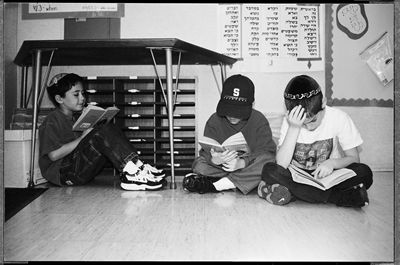
When Schools Compete: A Cautionary Tale
by Edward B. Fiske & Helen F. Ladd
Brookings Institution Press, 2000; $18.95 (paper), $47.95 (cloth); 342 pages
As reviewed by Jennifer L. Hochschild
Americans are notoriously solipsistic in designing and evaluating public policies. Whether this stems from a belief in American exceptionalism, a conviction that no other nation can teach us anything of deep value, or a sense of being sufficiently overwhelmed by the complexities within our country, we seldom seek to learn from the experiences of other nations. This is surely a mistake. It is a rare pleasure, then, to find a book that carefully examines the practices of another country with regard to a policy with which we are still experimenting.
About a decade ago, New Zealand devolved educational management authority to its schools and allowed students to choose among public schools. The top-heavy Department of Education became the lean Ministry of Education, schools were encouraged to diversify to attract students, and geographic districting was abolished. These changes look a lot like charter schools and public-school choice in the United States. Edward Fiske and Helen Ladd’s When Schools Compete builds on this resemblance to draw lessons from New Zealand’s experience that will help Americans mimic its successes and avoid its flaws if we quickly move toward a major expansion of charters and choice.
New Zealand’s isolation makes it a good laboratory, since the effects of a policy change will not be diluted by, say, massive immigration or international economic tidal waves. Its population is that of a mid-sized American state-the authors suggest Kentucky-which is the arena in which most important education policy choices are made in the United States. It has the same racial and ethnic complexities as the United States, the same dominant Anglo culture, and the same pragmatic ex-colonial attitude toward governmental activity. The authors concentrate on the three largest urban areas, which resemble medium-sized American cities.
| Almost everyone-parents, teachers, and public officials-likes the new system better than the old one. |
The education reforms that began under a left-wing Labor government in 1989 and were extended under a right-wing National government in 1991 combined three philosophical currents-democratic-populist, managerial-business, and New Right-market. Democratic populism was most evident in the devolution of control to elected boards of trustees comprising parents and community members. The managerial perspective was on display in the ministry’s continued insistence that better management was almost the only means of reversing a school’s failure. The New Right current generated the practice of parents choosing schools (or increasingly, as Fiske and Ladd found, of allowing schools to choose students). It also showed up in the assumption that schools are like firms-hopelessly bad ones will be forced out of business; market competition will induce poor ones to improve; and good ones will attract a clientele and expand. Overall, the quality of the product-that is, schooling-will improve for everyone.
During the 1990s contradictions surfaced among these three currents. The democratic-populist current was largely submerged, as the interests of parents of current students trumped the interests of the community or the nation as a whole and as competition among schools overrode any willingness to share ideas or to move in untried directions. The managerial current remains strong, but the market current remains probably the most powerful, even though its assumption that a rising tide would lift all boats has been only partially borne out. In short, the philosophies are in tension with one another, and all have had to confront the fact that schools are political entities in a complex social context-which inevitably muddies the clarity of any model.
Ruthlessly Utilitarian
Fiske and Ladd find that almost everyone-parents, teachers, principals, and public officials-likes the new system better than the old one; overweening bureaucratic control has no defenders. Popular schools have gained in popularity; unpopular schools have lost students; some schools in the middle have shown initiative and imagination, but many have not. Parents define a successful school largely by the socioeconomic status and race of its students; the ministry defines a successful school as one to which more and more people seek admission. A majority of urban primary schools can now choose among applicants. Unsuccessful schools are caught in a spiral of failure: “Rolls decline, which leads to a reduction in staff, which affects the quality of the academic program, which triggers unfavorable reviews and negative publicity, which makes it even more difficult to attract skilled staff,” which further reduces rolls. Privileged parents exercise more choice; parents of undesirable children or those who live in rural areas are occasionally reduced to begging any school to enroll their child. In short, the market works, for better and for worse.
The upshot is that schools are more polarized by race, ethnicity, and socioeconomic status than they were a decade ago. Some Maori, Pacific Island, and poor white children receive a better education than they would have under the old system. Average performance in successful schools has improved over the decade, while average performance in unsuccessful schools has declined. Poor schools have an increasingly disproportionate share of previously suspended students. There is little innovation, since schools that cater to a niche market do poorly under the logic that “bigger is better.”
The Ministry of Education now recognizes that failing schools need more than management training and a little extra funding. The ministry is hampered, however, by not only the political distastefulness of admitting failure, but also the fact that none of the three philosophical currents offers a model for rescuing failing schools. It is slowly moving to reinstate some geographic districting and to take some control over enrollment schemes. Fiske and Ladd conclude with a cautious hope that New Zealand is edging toward alleviating the worst problems generated by its reforms.
| New Zealand’s schools are more polarized by race, ethnicity, and socioeconomic status than they were a decade ago. |
What lessons should we draw? New Zealand’s reforms are not exactly what the United States would implement. New Zealand’s teacher unions are different, it has fewer charter and private schools, it lacks the three-layered federalism of the United States, and it has no cities comparable to New York or Los Angeles. But I am convinced that the basic dynamic of New Zealand would recur here. Market dynamics are very powerful; parents’ desire to surround their children with others of the “right” race and class may be even more powerful. Poor and minority children bring just as many problems to schools here as they do in New Zealand, especially when poverty is concentrated. With school choice, U.S. schools would be just as reluctant to take on the tough cases.
So would a move toward more choice and more decentralization benefit children more than alternative reforms would? The answer to that depends on how ruthlessly utilitarian one chooses to be. More children probably get better schooling now than they did a decade ago in New Zealand, and a minority get worse schooling. Some will see that as an acceptable trade-off; others will not. To a classic utilitarian, the risks of moving fully into the managerial/market currents may well outweigh the benefits. However, the rights of some to decent public schooling cannot be sacrificed for the good of others. If the move toward choice continues, we can perhaps mitigate its worst features by heeding the lessons of When Schools Compete.
-Jennifer L. Hochschild is a professor of government and Afro-American studies at Harvard University.
As reviewed by Mark Harrison
The education reforms of the early 1990s dramatically changed New Zealand’s highly centralized school system. Years before the first charter school was established in the United States, all government schools in New Zealand became something akin to charter schools, each governed by a board of trustees dominated by parents. Parents also were given the right to choose among government schools instead of being zoned to particular schools.
Despite acknowledging that “no one in New Zealand wants to return to the old system,” Edward Fiske and Helen Ladd are largely negative in their conclusions about choice and school autonomy, arguing that they fail to improve schools in low-income areas and instead often exacerbate their problems.
This conclusion, even if correct, can be applied only to the particular form of competition, choice, and autonomy introduced in New Zealand. Competition and choice among government-run schools falls far short of what is ordinarily meant by market competition, which requires the free entry of, and choice among, different types of providers. Furthermore, the schools in New Zealand were given limited autonomy. The Ministry of Education and the unions still negotiate the national collective contract that determines pay and conditions for most teachers. The ministry sets each school’s budget and the size of the staff at most schools. The Teacher Registration Board limits whom schools can hire (though it does not restrict their ability to fire). The ministry also controls teacher training, property management, major maintenance, and assessment services. It regulates the curriculum and imposes process requirements on how boards operate. That this truncated form of autonomy wasn’t as successful as expected should come as no surprise.
Fiske and Ladd weave a negative scenario of how the reforms played out. They claim that parents prefer schools with high proportions of white and privileged students. Privileged students, they claim, were the first to leave schools with high proportions of low-income and minority children. Schools in low-income areas spiral downward as poverty concentrates within them. Choice creates rather than exposes bad schools.
Ladd and Fiske assert that minorities are now more concentrated in low-performing schools; that minority and poor students are least likely to exercise choice; that dezoning increased segregation by ethnicity and income; and that dezoning made low-income and minority students worse off. Indeed, they conclude that choice is “a system set up to create unsuccessful schools and loser students” and that the reforms involved “the deliberate creation of relative failures.”
In fact, Fiske and Ladd’s evidence points to an alternative, more positive scenario. Before the reforms, bad schools existed. Zoning forced children to remain in these schools. The bad schools tended to be in poor areas because the poor lack political clout and possess fewer alternatives, such as sending their children to private schools, than the privileged. Moreover, good teachers tended to gravitate to schools in well-to-do neighborhoods.
However, dezoning allowed many dissatisfied parents, including many minority and low-income parents, to withdraw their children immediately from poorly performing schools. Choice allowed more low-income students to attend good schools. Although severely disadvantaged students may have been marooned in declining schools, low-income and minority parents took the most advantage of choice. This is because they are more likely than privileged students to need to leave their local zones in order to attend a good school. Although segregation increased in the worst schools, the net effect of low-income children’s attending schools outside their zones was to decrease segregation.
Fiske and Ladd do establish that choice makes life difficult for some schools. Schools with high proportions of low-income students are more likely to have lost enrollments. These schools have been left with concentrations of poor and minority students.
| Low-income and minority students have taken the greatest advantage of choice. |
In the end, however, there are actually fewer minority students in these schools as a result of choice. In fact, the Smithfield Project, from which Fiske and Ladd derive some of their data, established that low-income and minority students have taken the greatest advantage of choice. Minority students in New Zealand are actually more likely to attend an out-of-zone school than other groups, a reverse of the situation under zoning. Dezoning allowed families who were poorer than average to exercise a choice previously available mainly to families with higher incomes.
What about those left behind? As Fiske and Ladd acknowledge, data are scarce on the performance of students in low-income schools. Fiske and Ladd point to a widening achievement gap between successful and unsuccessful schools. Nevertheless, the fact that some schools have declined as a result of the reforms is not enough to establish that students in those schools are any worse off. If schools with declining enrollment are losing their best students to other schools, their performance will worsen even if the performance of their remaining students stays the same.
Segregation?
Fiske and Ladd claim that New Zealand’s reforms have contributed to socioeconomic and ethnic polarization. They compared enrollment patterns in the Auckland, Christchurch, and Wellington urban areas with changes in the number and ethnic composition of school-age children in the schools’ attendance zones. Segregation in state schools increased by about 1 percent in primary and intermediate schools and by about 3 percent in secondary schools from 1991 to 1996. Residential segregation fell over the same period.
These changes hardly represent polarization, but the authors want to attribute the difference between the rise in school segregation and the decline in residential segregation to the segregating effects of school choice. However, residential decisions are affected by whether parents can choose their schools. Dezoning divorces a family’s housing decision from the decision about where to send its child to school. In the end, this can promote residential integration. Families will be more willing to seek cheap housing in low-income areas if they can send their kids to school elsewhere. If school zoning had continued, residential segregation (and school segregation) might well have been greater than it is now.
Fiske and Ladd’s conclusion that segregation by income also increased as a result of choice is equally flawed. Selectively quoting the Smithfield Project, they compare segregation in 1991 with that in 1993 and 1996. As the Smithfield report emphasizes, however, 1990 was the final year of zoning; choice among government schools was introduced in 1991. This led to a dramatic and immediate exodus from some schools. In the Smithfield sample, from 1990 to 1991 the proportion of students not using their local school increased from 22 percent to 31 percent. The proportion fell slightly over the following two years.
That is, Fiske and Ladd failed to compare segregation under dezoning with segregation under zoning. In fact, the Smithfield report finds that, although income segregation rose from 1991 to 1993, it was still lower than in 1990, the final year of zoning. The evidence is that choice among government schools reduced income segregation.
Like Fiske and Ladd, the Smithfield Project found that dezoning caused a slight rise in ethnic segregation. Choices made by Maori families (such as attending schools emphasizing Maori culture) contributed to the increase in the segregation of Maori and white students under dezoning. Many would agree that Maori parents should be free to send their children to schools that emphasize Maori language and culture, but these decisions inevitably increase white/Maori segregation.
Fiske and Ladd assume that central authorities can and will institute policies to fix the problems of low-income schools. What they neglect to explain is why these magical policies were not adopted in the past and what they would look like in practice. For example, they urge the introduction of “managed or controlled choice” under which “students would be assigned to schools based on their preferences in a way that balanced their interests against the interests of other students and the community as a whole.” The only aspect Fiske and Ladd are clear on is that “unpopular schools would not lose as many students as they would under an unmanaged system.” In effect, students would be held hostage in failing schools until the educational bureaucracy eventually came up with a policy that worked. What a choice.
Mark Harrison is an independent economic consultant in Canberra, Australia.





